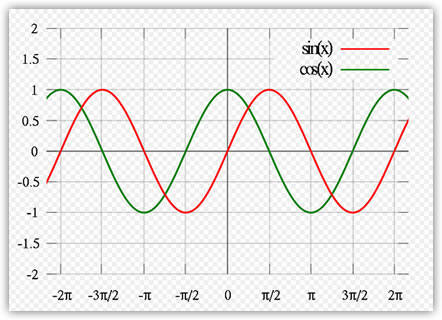|
by
kirupa | 2 October 2009
In the
previous page, you learned a bit about
trigonometric animations at a very high level. In this page,
let's go a little deeper and look at how these functions can
be represented in code.
There are three common trigonometric functions - Cosine,
Sine, and Tangent. For animations, you will rarely use
Tangent, so let's just focus on Cosine and Sine. In
ActionScript, the syntax for accessing them both is:
- Math.sin(number);
- Math.cos(number);
If you take a graphing calculator, if you graph the above
two functions, you would basically get the exact chart you
saw in the previous page. The value you pass in as an
argument to Math.sin() or Math.cos() is the angle, and that
is what you see on the x-axis.

Compare the values from the chart to what I input
into Flash below:
- // 0
- Math.sin(-2
* Math.PI);
-
- // 1
- Math.sin(-1.5
* Math.PI);
-
- // 0
- Math.sin(-1
* Math.PI);
-
- // -1
- Math.sin(-.5
* Math.PI);
-
- // 0
- Math.sin(0
* Math.PI);
-
- // 1
- Math.sin(.5
* Math.PI);
-
- // 0
- Math.sin(1
* Math.PI);
-
- // -1
- Math.sin(1.5
* Math.PI);
-
- // 0
- Math.sin(2
* Math.PI);
I basically took the key angles from our chart and placed
them into Flash just to show you how to map between the
chart and code. If you pass in any other intermediate angle,
you will find that your output is exactly the same as what
it would be if you relied on the chart, but the chart makes
it a bit difficult to read values that are not -1, 0, or 1.
Note
Notice I am entering the angle by
using the built-in constant for PI (Math.PI) instead of just
approximating to 3.14. I am doing this to ensure the result
is exactly the same as that of the chart, but you do not have to
do this.
You
can definitely use decimals as well, for PI is nothing more
than 3.14159.... The only thing to note is that, by going
all decimals, you do lose a certain amount of precision. Keep that in mind if such precision is important to you!
For
example, Math.sin(PI) is
0.
Math.sin(3.14159) is
0.000002653589793352726. The answer is close to 0,
but close may not be quite right.
Now that you have seen the code for usng the Sine and Cosine
functions, let's look at placing them in a simple
application. I have created a simple application for you to
get started on, so please download it from the following
location:
Download Partial Source Files
Don't worry. The application I have provided just saves
you some time without giving away anything that might be
important. All I have done is created a ColorfulCircle movie
clip class, drew instances of that class on the artboard,
and added an ENTER_FRAME event handler. In case you are
curious, you can learn in
detail how this was all done in the
Classes and MovieClips tutorial.
Anyway, once you have downloaded and extracted the files, go
ahead and open both trig_animation_flash.fla
as well as ColorfulCircle.as. The Flash
file only contains a few circles:

[ what your artboard looks like ]
These circles are instances of the the ColorfulCircle
movie clip, and this movie clip has an associated class file
that is stored in the ColorfulCircle ActionScript file. If
you switch over to that file, you will find the following
code:
- package
{
- import
flash.display.*;
- import
flash.events.*;
- import
flash.geom.*;
-
- public
class
ColorfulCircle
extends
MovieClip
{
-
- public
function
ColorfulCircle()
{
- this.addEventListener(Event.ENTER_FRAME,
flyCircleIn);
- }
-
- function
flyCircleIn(e:Event)
{
-
- }
- }
- }
If you run your application right now, nothing will
happen. The reason is that we haven't actually specified
what our application will do. That's what the
next page is
for!
Onwards to the
next page.
|